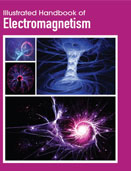Handbooks

Electromagnetism is a branch of physics involving the study of the electromagnetic force, a type of physical interaction that occurs between electrically charged particles. The electromagnetic force plays a major role in determining the internal properties of most objects encountered in daily life. Ordinary matter takes its form as a result of intermolecular forces between individual atoms and molecules in matter, and is a manifestation of the electromagnetic force. Electrons are bound by the electromagnetic force to atomic nuclei, and their orbital shapes and their influence on nearby atoms with their electrons is described by quantum mechanics. The electromagnetic force governs the processes involved in chemistry, which arise from interactions between the electrons of neighboring atoms. This illustrated work aims to cover some additional aspects of theory and nearly all modern applications.
Electromagnetism is the branch of physics that deals with electricity and magnetism and the interaction between them. It was first discovered in the 19th century and has extensive application in today?s world of physics. Electromagnetism is basically the science of electromagnetic fields. An electromagnetic field is the field produced by objects that are charged electrically. Radio waves, infrared waves, Ultraviolet waves, and x-rays are all electromagnetic fields in a certain range of frequency.
Illustrated Handbook of Electromagnetism covers the theoretical problems of modeling electrical behavior of the interconnections encountered in everyday electronic products. The electromagnetic force is one of the four elementary interactions in Nature. The electromagnetic force is responsible of lots of phenomena: intermolecular bonding in ordinary matter, electromagnetic waves, and electrons are bound to nucleus by the electromagnetic force etc. Ordinary matter takes its form as a result of intermolecular forces between individual atoms and molecules in matter, and is a manifestation of the electromagnetic force. Electrons are bound by the electromagnetic force to atomic nuclei, and their orbital shapes and their influence on nearby atoms with their electrons is described by quantum mechanics. The electromagnetic force governs the processes involved in chemistry, which arise from interactions between the electrons of neighboring atoms. Although electromagnetism is considered one of the four fundamental forces, at high energy the weak force and electromagnetic force are unified as a single electroweak force. Electromagnetism has numerous applications in today?s world of science and physics. Everyday modern life is pervaded by electromagnetic phenomena. In simple terms, every time we turn a power switch on, every time we press a key on our computer keyboard, or every time we perform a similar action involving an everyday electrical device, EM comes into play. It is the foundation for the technologies of electrical and computer engineering, spanning the entire electromagnetic spectrum, from dc to light, from the electrically and magnetically based technologies to the electronics technologies to the photonics technologies. The study of EM has direct relevance to understanding how light interacts with tissue, and novel technology for medical and biological imaging can be developed based on these EM principles. Illustrated Handbook of Electromagnetism provides a carefully structured, coherent, and comprehensive treatment in electromagnetism. This Handbook will serve both students and researchers involved in physics or electrical engineering.